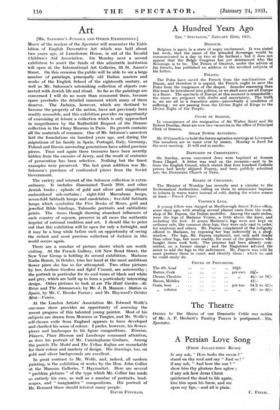Art
[MR. SALOMON'S JUDAICA AND OTHER EXHIBITIONS.]
MANY of the readers of the Spectator will remember the Exhi- bition of English Decorative Art which was held about two years ago, at Lansdowne House, in aid of the Invalid Children's Aid Association. On Monday next a second exhibition to assist the funds of this admirable institution will open at the International Art Galleries, 33 St. James's Street. On this occasion the public will be able to see a large number of paintings, principally old Italian masters and works of the English School of the eighteenth century, as well as Mr. Salomon's astonishing collection of objects con- nected with Jewish life and ritual. So far as the paintings are concerned I will do no more than commend them, because space precludes the detailed comment which many of them deserve. The Judaica, however, which are destined to become the property of the nation, have not previously been readily accessible, and this exhibition provides an opportunity of examining at leisure a collection which is only approached in magnificence by the Rothschild Bequest of the Strauss collection in the Cluny Museum in Paris. Its growth contains all the materials of romance. One of Mr. Salomon's ancestors laid the foundations six hundred years ago, and during the migrations of his family in Spain, Portugal, Italy, Germany, Poland and Russia succeeding generations have added precious pieces. Time and again these treasures have been secretly hidden from the enemies of Jewry, and the result of centuries of persecution has been selective. Nothing but the finest examples were preserved. The last great addition was Mr. Salomon's purchase of confiscated pieces from the Soviet Government.
The variety and interest of the Salomon collection is extra- ordinary. It includes illuminated Torah MSS. and other Jewish books ; ephods of gold and silver and magnificent embroidered ark-curtains ; eight-fold Maccabean lamps, seven-fold Sabbath lamps and candelabra ; five-fold Sabbath lamps which symbolize the Five Books of Moses, gold and jewelled Bible bindings, Talmudic portraits and cabbalistic prints. The items though showing abundant influences of each country of sojourn, preserve in all cases the authentic imprint of national tradition and art. I should like to point out that this exhibition will be open for only a fortnight, and it may be a long while before such an opportunity of seeing the richest and most precious collection of Judaica in the world occurs again.
There are a number of picture shows which are worth visiting. At the French Gallery, 158 New Bond Street, the New Year Group is holding its second exhibition. Madame Nadia Benois, in October, tries her hand at the most ambitious flower piece she has so far attempted. Two other pictures by her, Lexham Gardens and Sybil Vincent, are noteworthy ; the portrait in particular for its cool tones of black and white and grey, which are built up to form a particularly interesting design. Other pictures to look at are The Hotel Garden—St. Briac and The Amanuensis, by Mr. J. B. Manson ; Station in Spain, by Mr. C. Brooke Farrar ; and Mr. Hayward's October Mist—Venice.
At the London Artists' Association Mr. Edward Wolfe's one-man show provides an opportunity of assessing the recent progress of this talented young painter. Most of his subjects are drawn from Morocco or Tangier, and Mr. Wolfe's self-chosen exile from England appears to have developed and clarified his sense of colour. I prefer, however, his flower- pieces and landscapes to his figure compositions. Zinnias, Flowers, Plum Blossom and Landscape command attention, as does his portrait of Mr. Cunninghame Graham. Among the pastels The Model and The Yellow Kaftan are remarkable for their colour and mastery of design. His drawings, too, on gold and silver backgrounds are excellent.
In great contrast to Mr. Wolfe, and, indeed, all modem painting, is the exhibition of works by the Hon. John Collier at the Museum Galleries, 7 Haymarket. Here are several " problem pictures " of the type which Mr. Collier has made so entirely his own, as well as a number of portraits, land- scapes, and " imaginative " compositions. His portrait of Mr. Bernard Shaw should interest many people.
DAVID FINCILAM,






































 Previous page
Previous page